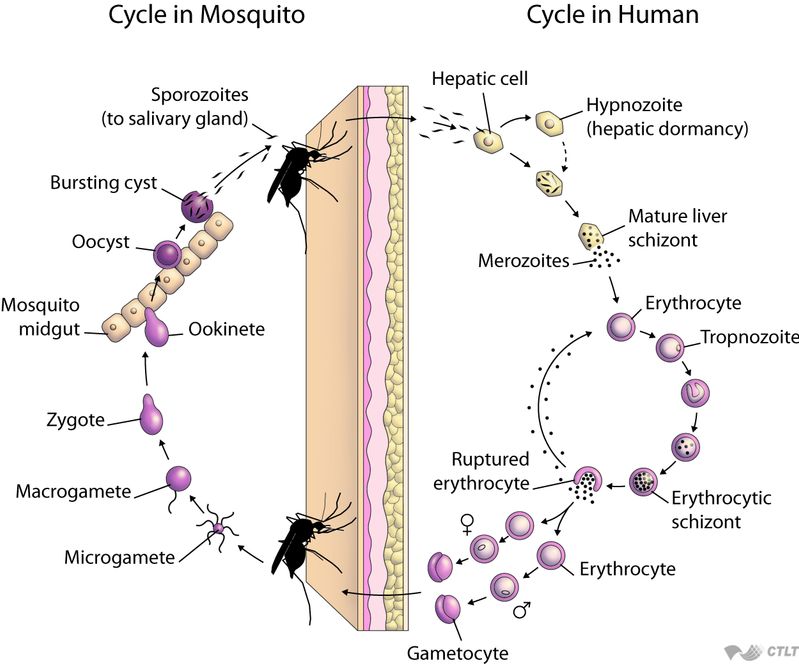Plasmodium species that infect humans
Until recently, there were four plasmodium species that were considered responsible for malaria disease in humans: P. vivax, P. falciparum, P. ovale and P. malariae. In 2008, P. knowlesi, a species that used to infect exclusively apes of the genous Macaque, was recognised by WHO as the fifth plasmodium species that infect humans.
Transmission routes
The main mode of transmission of the disease is by bites from infected Anopheles mosquitoes that have previously had a blood meal from an individual with parasitemia. Less common routes of transmission are via infected blood transfusion, transplantation, infected needles, and from a mother to her fetus during pregnancy.
Plasmodium life cycle
The life cycle (Figure 1) is almost the same for all the five species that infect humans and follows three stages:
(I) ifection of a human with sporozoites
(II) asexual reproduction
(III) sexual reproduction
The two first stages take place exclusively into the human body, while the third one starts in the human body and is completed into the mosquito organism.
 Figure 1. Plasmodium life cycle
(Source: Open Course Ware)
Figure 1. Plasmodium life cycle
(Source: Open Course Ware)
The human infection begins when an infected female anopheles mosquito bites a person and injects infected with sporozoites saliva into the blood circulation. That is the first life stage of plasmodium (stage of infection).
The next stage in malaria life cycle is the one of asexual reproduction that is divided into different phases: the pre- erythrocytic (or better, exoerythrocytic) and the erythrocytic phase. Within only 30- 60 minutes after the parasites inoculation, sporozoites find their way through blood circulation to their first target, the liver. The sporozoites enter the liver cells and start dividing leading to schizonts creation in 6- 7 days. Each schizont gives birth to thousands of merozoites (exoerythrocytic schizogony) that are then released into the blood stream marking the end of the exoerythrocytic phase of the asexual reproductive stage.
It is worth mentioning that, concerning P. vivax and P. ovale, sporozoites may not follow the reproduction step and stay dormant (hypnozoites) in the liver; they may be activated after a long time leading to relapses entering the blood stream (as merozoites) after weeks, months or even years. The exoerythrocytic phase is not pathogenic and does not produce symptoms or signs of the disease. Its duration is not the same for all parasite species.
Merozoites released into the blood stream, are directed towards their second target, the red blood cells (RBCs). As they invade into the cells, they mark the beginning of the erythrocytic phase. The first stage after invasion is a ring stage that evolves into a trophozoite. The trophozoites are not able to digest the haem so they convert it in haemozoine and digest the globin that is used as a source of aminoacids for their reproduction. The next cellular stage is the erythrocytic schizont (initially immature and then mature schizont). Each mature schizont gives birth to new generation merozoites (erythrocytic schizogony) that, after RBCs rupture, are released in the blood stream in order to invade other RBCs. This is when parasitaemia occurs and cinical manifestations appear. The liver phase occurs only once while the erythrocytic phase undergoes multiple cycles; the merozoites release after each cycle creates the febrile waves.
A second scenario into the RBCs is the parasite differentiation into male and female gametocytes that is a non pathogenic form of parasite. When a female anopheles mosquito bites an infected person, it takes up these gametocytes with the blood meal (mosquitoes can be infected only if they have a meal during the period that gametocytes circulate in the human’s blood). The gametocytes, then, mature and become microgametes (male) and macrogametes (female) during a process known as gametogenesis. The time needed for the gametocytes to mature differs for each plasmodium species: 3- 4 days for P. vivax and P. ovale, 6- 8 days for P. malariae and 8- 10 days for P. falciparum.
In the mosquito gut, the microgamete nucleus divides three times producing eight nuclei; each nucleus fertilizes a macrogamete forming a zygote. The zygote, after the fusion of nuclei and the fertilization, becomes the so- called ookinete. The ookinete, then, penetrates the midgut wall of the mosquito, where it encysts into a formation called oocyst. Inside the oocyst, the ookinete nucleus divides to produce thousands of sporozoites (sporogony). That is the end of the third stage (stage of sexual reproduction/ sporogony). Sporogony lasts 8- 15 days.
The oocyst ruptures and the sporozoites are released inside the mosquito cavity and find their way to its salivary glands but only few hundreds of sporozoites manage to enter. Thus, when the above mentioned infected mosquito takes a blood meal, it injects its infected saliva into the next victim marking the beginning of a new cycle.
The duration of each above desribed phase is different for each of the plasmodia as shown in Table 1 that follows.
| |
Plasmodium species
|
| |
P. vivax |
P. ovale |
P. malariae |
P. falciparum |
| Pro-erythrocytic phase (days) |
6-8 |
9 |
14-16 |
5-7 |
| Erythrocytic cycle (hours) |
48 |
50 |
72 |
48 |
| Incubation period (days) |
12-17 or even 6-12 months |
16-18 or more |
18-40 or more |
9-14 |
| Sporogony (days) |
8-10 |
12-14 |
14-16 |
9-10 |